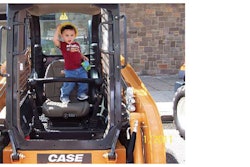By Mike Anderson
Impressing veteran equipment operators is never easy. For Georgia contractor Lee Deas IV, though, a light bulb turned on the day he pulled himself into the cab of a 72,000-pound crawler excavator.
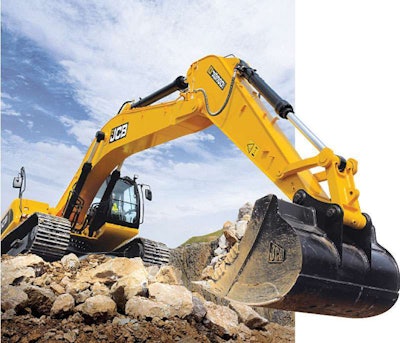 Automatic warm-up and overheat protection systems are standard on the Tier 4 Interim Isuzu engines used by JCB on its excavators, including the 82,829-pound JS360 shown here in a common LC configuration. A reinforced XD version for demolition and land-clearing applications was recently introduced.
Automatic warm-up and overheat protection systems are standard on the Tier 4 Interim Isuzu engines used by JCB on its excavators, including the 82,829-pound JS360 shown here in a common LC configuration. A reinforced XD version for demolition and land-clearing applications was recently introduced.“I’ve run small excavators my whole life, but it’s a whole different ballgame when you get on something that big,” says Deas, owner of Precision Site Works, based in the Augusta suburb of Evans. “It just opened up my eyes on how much more production can be done with that machine versus the smaller machines. It’s just amazing the difference.”
A year-and-a-half after buying the 33-metric-ton JCB, Deas couldn’t be happier. And it’s not only about digging and loading more dirt. When his JS330LC is not being used to lay pipe at the new fixed-base operator (FBO) terminal being built at Augusta Regional Airport, it is demolishing concrete at the nearby James B. Messerly Waste Water Treatment Plant. “It’s fantastic,” he says. “We run it every day, and we haven’t had a minute’s trouble out of it.”
Deas, who owns other brands in smaller size classes, is emblematic of two market trends cited by excavator manufacturers:
• a migration of excavator sales from the 20-metric-ton class – the traditional “sweet spot” – up to the 30-metric-ton class, for which some limited anecdotal evidence exists.
• the expanded use of machines 30 metric tons and up in various applications beyond traditional bucket use.
“This size of machine is now being used like a smaller machine,” says Joel Escalante, Volvo’s global competence development manager, excavators. “You need to plug different tools in.”
Volvo’s newest Tier 4 Interim-compliant model, the 30-metric-ton-class EC300D, leverages a “more sophisticated” auxiliary hydraulics system, complemented by the ability to input settings for up to 20 different tools, says Escalante. Traditionally, to work a mower or grinder attachment, the owner of an excavator this size would need to acquire – at a cost of about $8,000 – special priority valving for the dedicated flow required, he says. “That is now gone,” says Escalante. “All the operator has to do is just plug-and-play. It is much more cost-effective.”
Meeting Tier 4 Interim emissions standards, now required for excavators in the 30- to 50-metric-ton range covered here, came down to a choice for manufacturers. The more common exhaust gas recirculation (EGR) approach entails extensive cooling systems, recirculation valves to divert a portion of the exhaust and a diesel particulate filter requiring active regeneration. The alternative selective catalytic reduction (SCR) approach – used by Kobelco with its new 68,343-pound SK295 Mark 9 model – involves the spraying of a urea-deionized water mix into the exhaust gases. And Tier 4 Interim engines require the use of low-ash engine oils and ultra-low-sulfur diesel fuel.
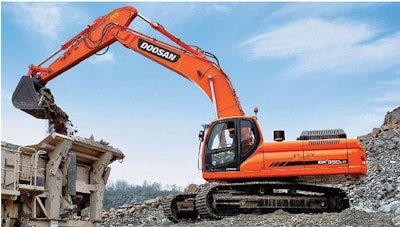 An electronic power optimizing system connects the Doosan excavator’s hydraulics system and engine controls via a data transfer link. The Doosan telematics system allows owners to monitor their machines from a computer or cell phone.
An electronic power optimizing system connects the Doosan excavator’s hydraulics system and engine controls via a data transfer link. The Doosan telematics system allows owners to monitor their machines from a computer or cell phone.Larger excavators have seen increased placement in rental fleets, says Tim O’Brien, Case brand marketing manager. “As customers who previously bought most or all their machines are now renting,” at the same time that dealerships and rental houses have been replenishing rental fleets, the result is a larger percentage of 30-metric-ton-plus machines being sold with auxiliary hydraulics and more couplers being ordered, says O’Brien. A machine traditionally used specifically by its owner is now increasingly available for rent for various applications and, thus, in need of varied work tools.
At World of Concrete 2012 in January, Case introduced “smart digging” components for excavators, including new pin-on buckets, coupler buckets, a multi-fit coupler and the hammerless SmartFit bucket teeth system.
Moving on up
Case itself is reflective of a market migration. Known for its compact, utility and general construction offerings, the company meets the demands of the 30- to 50-metric-ton excavator market with the CX350C and CX470C, the latter just about to hit the market, says O’Brien. “We can compete very well,” he says, “and again I think the 30-metric-ton-plus market is changing to a more rental business model, where we can compete even more effectively. Our dealers have developed a good capability in the rental business.”
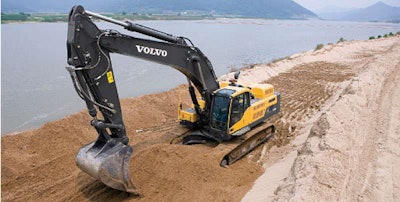 The undercarriages on Volvo’s larger D-Series excavators, including the 105,000-pound EC480D, are beefed up with thick gauge metal plates, track guards and bolt-head protection. Heavy-duty booms are standard.
The undercarriages on Volvo’s larger D-Series excavators, including the 105,000-pound EC480D, are beefed up with thick gauge metal plates, track guards and bolt-head protection. Heavy-duty booms are standard.Case product marketing manager George Whitaker praises what he’s seen in 30- to 50-metric-ton excavators in the North American market (see Machine Matters Roundup, starting on page 18). What struck him as he walked around last year’s CONEXPO-CON/AGG show were the assorted cab, hydraulics and overall performance improvements made by the players in the market. The machines, he says, are more comfortable, more responsive and faster for operators. “The whole excavator community achieved a lot with Tier 4 Interim,” he says. “You really have to look at the industry with a lot of pride. They took something that frankly consumed a lot of resources – time, money and people – and moved on from that to make a much better product.
“Obviously, there was some price to pay in the marketplace, but I think customers are getting a good value for their money,” says Whitaker.
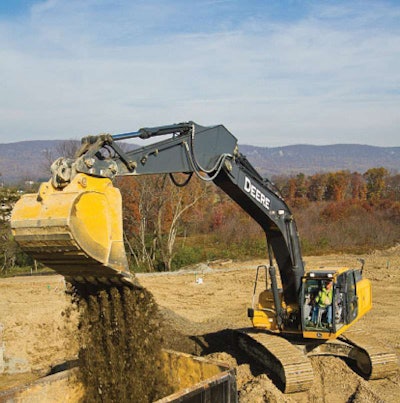 The 350G LC excavator’s high-productivity mode answers the demand of North American customers for excavators that can load more trucks in a day, says John Deere. To assist the operator, the updated cab has more glass and lighting.
The 350G LC excavator’s high-productivity mode answers the demand of North American customers for excavators that can load more trucks in a day, says John Deere. To assist the operator, the updated cab has more glass and lighting.Multi-state infrastructure contractor Goodfellow Bros. in Wenatchee, Washington, is kicking off 2012 by adding seven Zaxis Dash-5 excavators in the 30- to 50-metric-ton range – five ZX470LC-5 machines and two ZX350LC-5 units. Of the larger model size, Hitachi’s replacement for the ZX450LC-3, two units were in the field already in late February, with 200-300 hours on them each. That’s too early for definitive feedback, says equipment manager John Stump, but “we’re very optimistic. We’ve had a long relationship with Hitachi and Deere, and they’ve always treated us right.”
Chuck Wyatt, who assists Stump on the maintenance side of the business, says the established use of low-ash engine oils and ultra-low-sulfur diesel fuel eases the maintenance transition, but “time will tell” if extra burdens come to fruition. “You’ve got more exhaust gas circulating back into the engine,” he says. “Is that going to shorten the life of the engine?” He’s optimistic, though, on Deere’s early feedback on filters indicating a longer lifespan than originally projected. (The Deere 350G LC and 470G LC are sister models to the Hitachi ZX350LC-5 and ZX470LC-5.)
Embracing the new technology is the only way for Goodfellow Bros. to go, says Stump. “From our standpoint, this is what’s coming. We’ve got to accept it; we’ve got to work with it.” The 76,258-pound ZX350LC-5 fits into Goodfellow’s most popular size class, because it offers a balance between the ability to be moved easily and yet still work on deeper trenching and even mass excavating, he says.
On the larger end, “we’ve been rolling out some of our higher-houred 450s,” which are being replaced with the 108,952-pound Hitachi ZX470LC-5 units.
Hitachi’s model designation change is not unique in the market.
“The nomenclature shift actually was to match the true weight of the machine, to be more close to realistic numbers, says Escalante at Volvo, which replaced the EC290C with the new EC300D. “In the past, it was sort of a range that everybody operated on, but it was agreed within all manufacturing companies to now be more close to the real weight of the machine with the nomenclature.”
Working smarter
Volvo, says Escalante, offers the Boom Float option that allows the operator to level the surface quickly with the excavator’s bucket – a maneuver that traditionally takes considerable skill, patience and time as the operator feathers the varying arm, stick and bucket movements required to keep the pressure of the bucket on the ground. “With Boom Float, the operator doesn’t have to think about it. All he has to put pressure down, bring the arm in and control the bucket,” he says.
With the CX350C and CX470C, the goal was to “strike a really good balance between speed, power, efficiency and the Case hallmark of machine controllability,” says Whitaker. “We wanted to add that full package,” says O’Brien, crediting global customer research that began with the launch of the company’s B Series. “We went beyond emissions compliance to provide a whole package of value to what those customers would expect, and even beyond their expectations when it comes to productivity and fuel consumption.
“It’s a crowded market of excavator suppliers. Although excavators may on the outside look very similar, there’s a lot of choice out there,” says O’Brien.
Whitaker can’t say enough about the 30- to 50-metric-ton excavators. “It was really quite an achievement to bring better and more productive products and Tier 4 Interim at the same time,” he says. “Tier 4 Final will be an interesting similar type of exercise: What else can we do to the machine to bring greater versatility and greater value for the money to the customer? The next two-and-a-half years will be interesting in terms of what develops.”
Whitaker isn’t sure if any perceived “sweet spot” migration to larger excavators is sustainable, but believes it is clearly present during an era when oil and gas, solar field and heavier civil infrastructure projects have replaced residential and light commercial projects for many contractors across North America.
“That is exactly right,” responds contractor Deas.
And, with smaller work slow right now, the Georgia contractor says he is planning to add more pieces of that “fantastic” big iron he’s newly discovered.
ROUNDUP
JCB
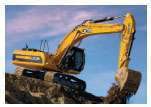 JS330LC
JS330LCNew versions of established model sizes are expanding JCB’s 30- to 50-metric-ton excavator product line. In addition to the standard long-carriage (LC) and extra-duty (XD), the 72,816-pound JS330 is now available in a long-reach (LR) configuration with a longer boom and dipper, particularly suited for waterways maintenance. The 82,829-pound JS360, along with the standard LC, comes in an XD version with a reinforced dipper and bucket linkage, extra plating, engine pre-cleaner and over-cab FOPS guard for rugged demolition and land-clearing applications. On both conventional JS and reduced-tail-swing JZ full-size excavators, JCB uses a single-piece, steel X-frame undercarriage with greased-for-life Berco track components. Turbocharged Isuzu engines, dishing out 271 horsepower for both the JC330 and JC360, have automatic warm-up and overheat protection systems. Auto-shift transmissions move to and from high, mid and low gears to match engine output with precise machine movement.
For product info: visit: jcbamericas.com
Komatsu
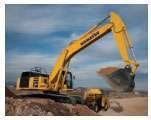 PC490LC-10
PC490LC-10Komatsu developed a hydraulically-actuated variable-geometry turbocharger and exhaust gas recirculation valve to help achieve Tier 4 Interim emissions standards on the Dash-10 versions of 30- to 50-metric-ton excavators, introduced in 2011. The Komatsu diesel particulate filter has an integrated design that does not interfere with daily operation, keeping the operator aware of its status. Komatsu designed all major components – including engines, hydraulic pumps and valves – on the 68,234-pound PC290LC-10, 79,930-pound PC360LC-10, 89,071-pound PC390LC-10 and 106,880-pound PC490LC-10. The resulting integrated design includes a closed center load-sensing hydraulic system that uses variable speed matching to adjust engine speed based on pump output. The engine’s electronic control system manages air flow rate, fuel injection, combustion parameters and aftertreatment functions.
For product info, visit: komatsuamerica.com
Case
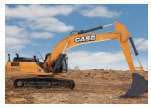 CX350C
CX350CWith its new C Series crawler excavators, including the 80,000-pound CX350C introduced last year, Case says it increased fuel efficiency from the B Series by up to 10 percent – particularly noteworthy considering the fuel efficiency on the B Series excavators earned Japan’s Energy Conservation Award. The Case intelligent hydraulic system technology reduces fuel consumption via such features as boom economy, auto economy, swing relief and spool spoke control. At a 5-percent uptick in cycle times, C Series excavators can load 10 more trucks per shift, says Case. The Tier 4 Interim-certified cooled EGR CX350C, rated at 266 net horsepower, has a rearview camera feeding video to an LED in-cab monitor. SmartFit teeth are now factory-installed as a standard feature on Case buckets purchased with large- and mid-range excavators, including the 103,800-pound CX470C just about to hit the market.
For product info, visit: casece.com
Hitachi
 ZX350LC-5
ZX350LC-5The Zaxis Dash-5 replacement for the slightly-lighter ZX450LC-3, the new 108,952-pound Hitachi ZX470LC-5 combines greater horsepower and optimized hydraulics for increased arm- and bucket-digging forces. The result, says Hitachi, is more material moved per gallon of fuel burned. Updates include a new lighting package with two cab lights and an additional boom light, a rear-view video camera, and a roomier cab with a larger door and more glass. The cab enhancements follow those introduced on the 76,258-pound ZX350LC-5 model. A heated, air-suspension version of the new high-back seat is standard on the 367-horsepower ZX470LC-5, optional on the 271-horsepower ZX350LC-5 (and ZX290LC-5, which bumps right up against the 30-metric-ton class). The Tier 4 Interim Isuzu engine leverages exhaust gas recirculation (EGR) technology – providing simple maintenance while delivering the productivity, fuel efficiency and reliability customers enjoyed with Tier 3 models, says Hitachi.
For product info, visit: hitachiconstruction.com
John Deere
 470G LC
470G LCDeere says its excavator customers want to load more trucks and place more pipe in less time, prompting the company to offer a high-productivity choice among the three power modes on its G-Series full-sized excavators. This includes the 108,952-pound 470G LC, which like the sister Hitachi ZX470LC-5 is powered by a 367-horsepower Isuzu Tier 4 Interim engine. Power mode offers a balance between production and fuel economy, levering the Powerwise III hydraulic management system; economy mode saves the most fuel possible. The 470G LC is the entry model in Deere’s “Production Class” family. Topping the “Construction Class” is the 76,557-pound 350G LC, driven by a 271-horsepower Deere PowerTech engine. Slipping into the 30- to 50-metric-ton range, at 66,338 pounds, is the 188-horsepower, Deere-powered 290G LC. Based on customer feedback, G-Series upper structures were redesigned to include more glass and lighting to improve operator sightlines.
For product info, visit: deere.com
Liebherr
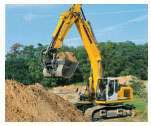 R944C
R944CLiebherr is in the process of transitioning its excavator product line, and new models will soon find their way into the North American market. The R936 and R946 will be the successors to the R934C and R944C; the R936, at about 31 metric tons, premieres this month at Intermat in Paris. The 218-horsepower R936’s Tier 4 Interim emissions solution combines an external exhaust gas recirculation system and a diesel particulate filter with active regeneration, Liebherr announced at a pre-Intermat sneak peak. Compared to the R934C, the R936 will have improvements of 13, 6 and 10 percent in swing torque, tearout and breakout forces, and will feature a new tooth system. A newly designed positive control hydraulic system ensures oil flow is distributed to circuits as necessary while maintaining efficient engine operation. Long standard on Liebherr excavators are heavy-duty undercarriage frames, boom and stick cylinder protection valves and automatic greasing systems.
For product info, visit: liebherr.us
Link-Belt
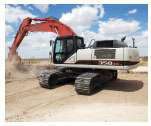 350 X3
350 X3Compared to previous-generation machines, the Tier 4 Interim Link-Belt X3 Series excavators are showing fuel economy improvements of 5 percent that LBX says will position them at the top of their classes. Powered by an Isuzu engine delivering 266 net horsepower, the 80,028-pound 350 X3 provides the speed, balance and precision needed for trenching and setting pipe, earthmoving and in some quarry applications, the company says. As with the 470 X3, which just creeps above the 50-metric-ton line at an operating weight of 111,554 pounds, the 350 X3 comes with standard control pattern change valve, rear-view camera and undercarriage swivel guard. Link-Belt’s Tier 4 Interim excavators use cooled exhaust gas recirculation and diesel particular filter technology. A new variable-geometry turbocharger provides high-velocity air flow at lower rpms for clean, efficient combustion and power, even when working at slower speeds.
For product info, visit: lbxco.com
Caterpillar
 349E L
349E LCaterpillar has transitioned its 30- to 50-metric-ton excavator offering to the Tier 4 Interim-compliant E Series, with a passive aftertreatment regeneration solution that ensures the machines work as normal with no operator intervention required. The 80,617-pound 336E L and 105,400-pound 349E L models have two programmable modes of operation. In automatic mode, the excavator starts the regeneration process once the filtering system reaches a certain level; it will not interrupt the work process and regenerate during machine operation. In manual mode, the operator can, with the touch of an in-cab button, override the automatic system to move the machine from flammable or heat-restricted areas before initiating the regeneration process. The 336E L has counterweight, undercarriage, boom and stick choices; the 349E L comes with variable or fixed track gauge, as well as boom and stick options. Depending on configuration, the smaller 329E L will also move above the 30-metric-ton mark.
For product info, visit: cat.com
Kobelco
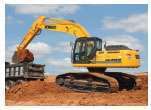 SK295 Mark 9
SK295 Mark 9Depending on the model, Kobelco achieves Tier 4 Interim emissions standards with its new Mark 9 excavators in different ways. The SK295 Mark 9, just over the 30-metric-ton threshold at 68,343 pounds, uses selective catalytic reduction (SCR) technology that delivers quicker response from a free-breathing FPT engine, the company says. The engine has no internal emission control, using only exhaust aftertreatment with diesel exhaust fluid injection and a no-maintenance catalytic chamber, in what Kobelco says is a unique application for excavators. The 80,909-pound SK350 Mark 9 uses cooled exhaust gas recirculation (CEGR) with a diesel particulate filter. This model has increased horsepower, an upgraded fuel system and a variable-geometry turbocharger. Both are available in various special configurations – High & Wide, Long Reach and Mass Excavation – as well as with undercarriage, frame, boom and arm options. Faster engine response and stronger power curves allow the hydraulics of the intelligent total control system to match engine output.
For product info, visit: kobelcoamerica.com
Doosan
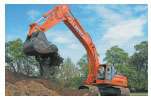 DX420LC
DX420LCSporting four different model sizes, Doosan’s 30- to 50-metric-ton range excavator offering includes two models recently updated to Tier 4 Interim emissions standards – the 67,900-pound DX300LC and 78,485-pound DX350LC – and is topped off by the 108,025-pound DX480LC. In between, Doosan is one of the few manufacturers to offer a 42-metric-ton excavator, the 92,364-pound DX420LC, providing customers with an option for jobs requiring an excavator larger than a 35-metric-ton yet not as large as a 48-metric-ton, the company says. Standard on all mid-size and heavy Doosan excavators, operators can engage auto-idle, which drops the engine to idle if functions aren’t used for four seconds. This reduces fuel consumption for the machine and creates a more comfortable work environment for the operator and nearby workers. The engine automatically returns to the pre-set throttle position as soon as the operator moves a joystick or travel function. The DX300LC is available in a long-reach SLR version.
For product info, visit: doosanequipment.com
Volvo
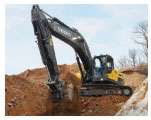 EC300D
EC300DNewest among the Volvo D-Series Tier 4 Interim excavators is the 66,140-pound EC300D, replacing the EC290C L with such features as a new 277-horsepower Volvo D8H engine and automatic sensing hydraulic system. As with the larger D-Series models introduced earlier in 2011 – the D13H-powered EC340D at 77,240 pounds, EC380D at 83,776 pounds and EC480D at 105,000 pounds – the EC300D’s hydraulic system leverages an “Eco” mode to avoid peak-pressure shocks and reduce energy loss. With a bucket digging force of 45,970 pounds, the EC300D offers gains of 11 and 18 percent in engine output and torque, says Volvo. The engine model on the larger units provides 283 net horsepower for both the EC340D and EC380D – the latter with almost 10,000 additional pounds of digging force – and jumps to 348 horsepower for the EC480D. Volvo also offers the short-swing, 77,940-pound ECR305C, powered by a 192-horsepower D7E engine.
For product info, visit: volvoce.com




